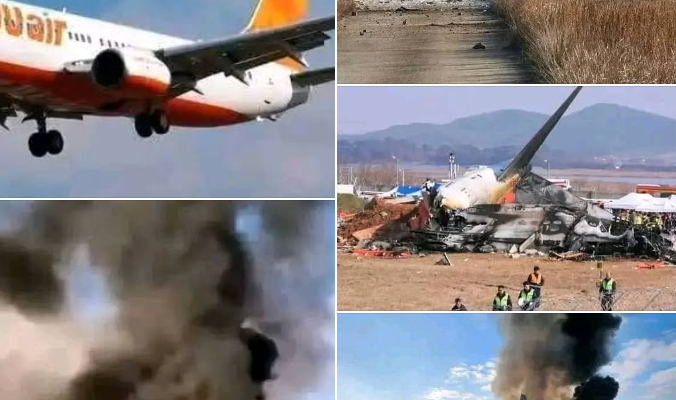All 181 passengers and crew aboard a passenger jet that crashed upon landing in South Korea on Sunday morning are presumed dead except for two people rescued from the wreckage, authorities said.
Jeju Air flight 2216 was landing at Muan International Airport around 9 a.m. local time when the plane went off the runway and crashed into a wall.
There were a total of 175 passengers and six crew members aboard the Boeing 737 aircraft, which had taken off from Bangkok, according to the Korean Ministry of Land Infrastructure and Transport. The official death toll, which has been provided by the National Fire Agency, has climbed steadily in the hours since the crash.

MORE: Survivors of Azerbaijan Airlines plane crash report hearing bangs, explosions during flight

The transport ministry was on the scene investigating the cause of the crash, and details of what happened were beginning to come into focus. Prior to the plane’s crash landing, the control tower issued a warning of a possible bird strike, the ministry said. About a minute after that warning, a pilot sent a mayday distress signal, after which the tower issued permission for the aircraft to land, the ministry said.
Video from the scene at the time of the crash appears to show the landing gear was up when the plane touched down, possibly indicating some sort of malfunction, and it also appears the plane landed at a high speed. Videos taken at the scene showed flames and a thick column of dark smoke at the crash site.

As of 1 p.m. local time, authorities said the plane had completely burned. A temporary morgue was being set up at the airport.
By about 8 p.m., the official death toll had climbed to 176 people, the National Fire Agency said. Eighty-three of the dead were women and 82 were men, the agency said, adding that another 11 bodies remained unidentified. According to the flight manifest, there were five children under 10 years old on the flight, the youngest of them 3 years old.
A man and a woman were rescued from the wreckage and were taken to the hospital, according to the transport ministry. Both were crew members, the fire agency said. Their conditions were not released.
Initially, there were conflicting reports on the number of people rescued.

Jeju Air is a South Korean low-cost carrier that operates an all Boeing fleet, with 42 planes and nearly 3,000 staff.
“We deeply apologize to all those affected by the incident at Muan Airport,” Jeju Air said in a notice posted in English on its website. “We will make every effort to resolve the situation. We sincerely regret the distress caused.”
The website’s landing page replaced Jeju Air’s logotype, which is usually orange, with an all-black version.

The National Transportation Safety Board (NTSB) posted on X Sunday that it is “leading a team of U.S. investigators (NTSB, Boeing and FAA) to assist the Republic of Korea’s Aviation and Railway Accident Investigation Board (ARAIB)” with their investigation of the crash, adding that the ARAIB would release any information about the investigation “per international protocols.”
Boeing was in contact with Jeju Air regarding the crash and was “standing ready to support them,” a Boeing spokesperson told ABC News earlier.
“We extend our deepest condolences to the families who lost loved ones, and our thoughts remain with the passengers and crew,” the spokesperson said.
Muan, a city of roughly 90,000 people, is located in southwest South Korea.
ABC News’ Jessica Gorman, Victoria Beaule and Rashid Haddou contributed to this report.

